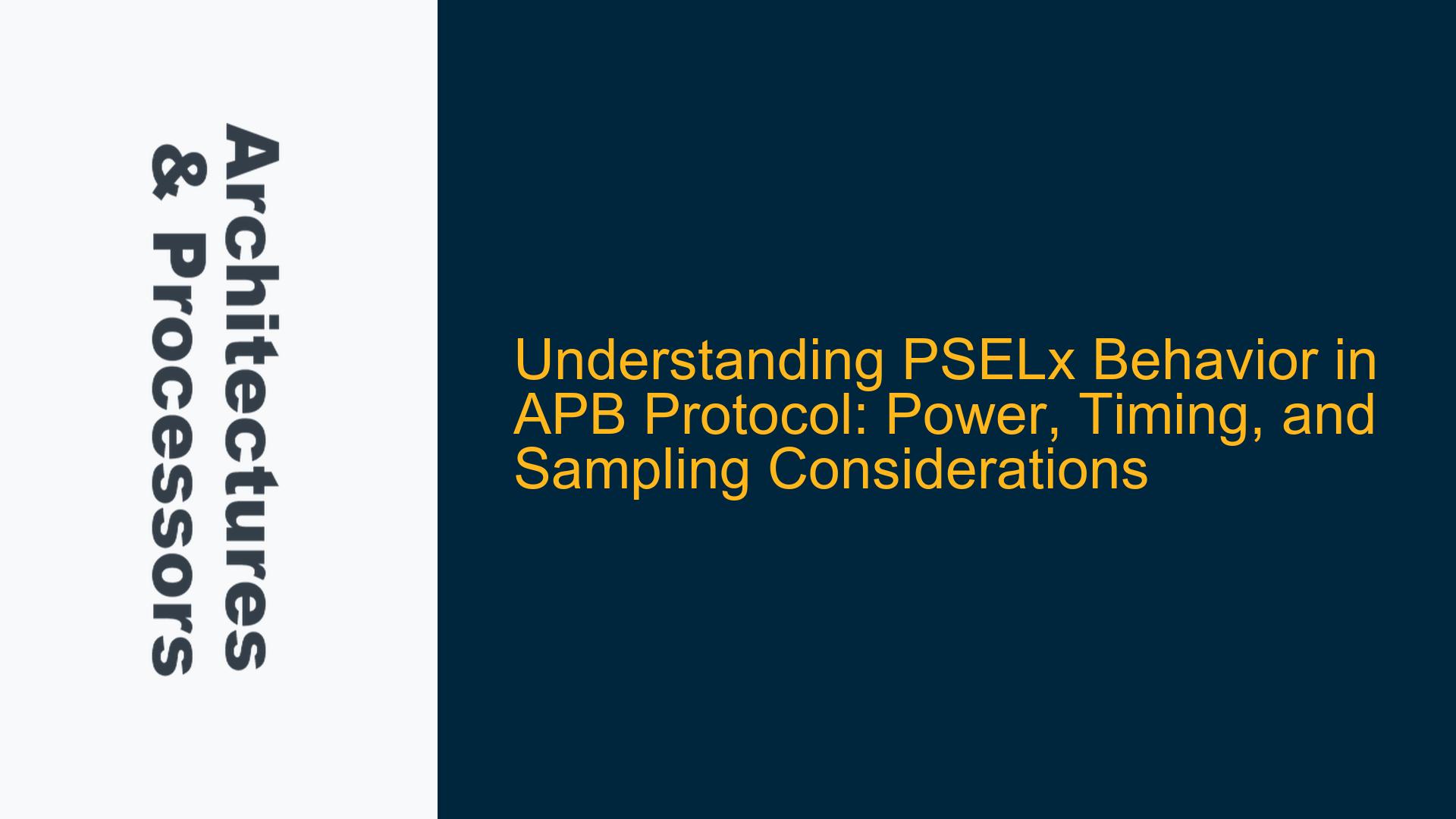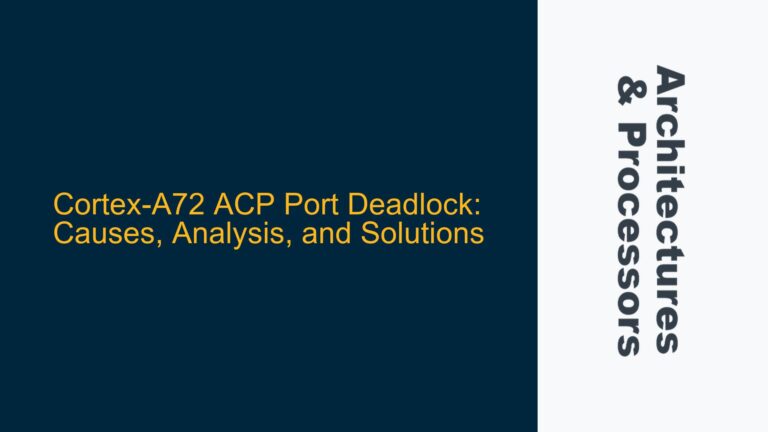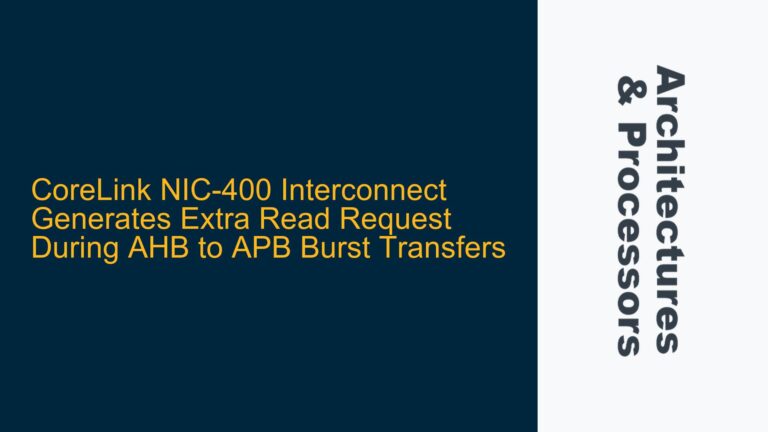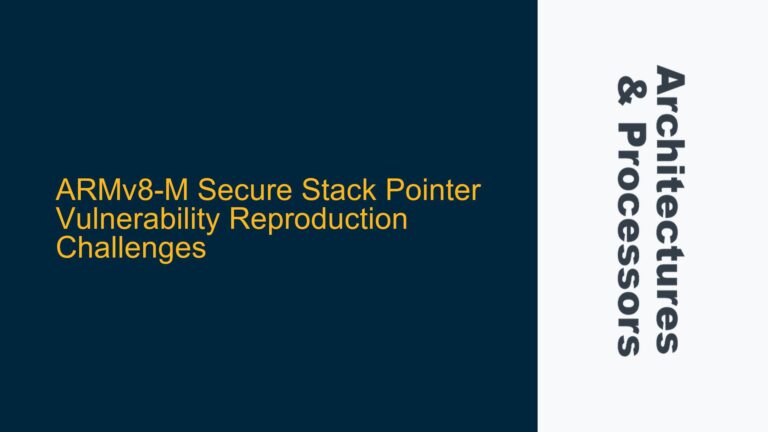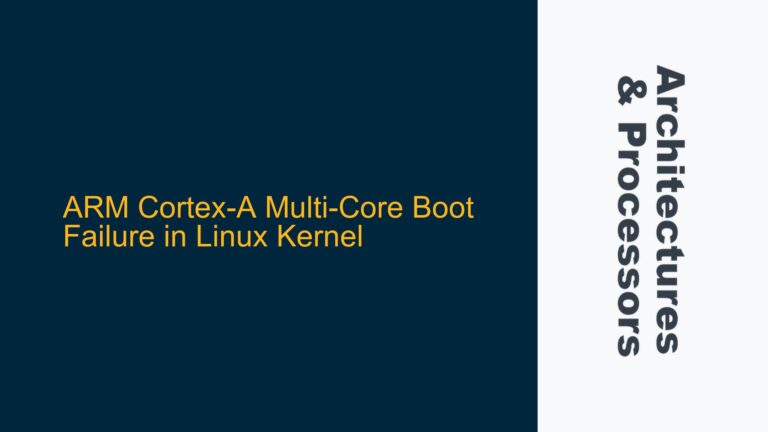APB Protocol Requirements for PSELx Deassertion After Transaction Completion
The Advanced Peripheral Bus (APB) protocol, part of the ARM AMBA family, is designed for low-power, low-complexity peripheral communication. One of its key requirements is that the peripheral select signal, PSELx, must be deasserted (set to 0) at the end of a transaction unless a back-to-back transfer is initiated. This requirement is often misunderstood, with some designers assuming that keeping PSELx asserted between transactions could save power by reducing signal toggling. However, this assumption overlooks the fundamental operation of the APB protocol and its implications for power consumption, timing, and peripheral behavior.
The APB protocol operates in two phases: the SETUP phase and the ACCESS phase. During the SETUP phase, PSELx is asserted, and the address (PADDR), write/read control (PWRITE), and other control signals are sampled by the peripheral. In the ACCESS phase, PENABLE is asserted, and the data transfer occurs. The protocol mandates that PSELx must be deasserted after the completion of a transaction to indicate the end of the current transfer and to prepare for the next transaction. This deassertion is critical for ensuring proper peripheral operation and minimizing power consumption.
When PSELx remains asserted after a transaction, the peripheral interprets this as the beginning of a new SETUP phase. This causes the peripheral to continuously sample PADDR and PWRITE, even when no valid transaction is occurring. This unnecessary sampling increases dynamic power consumption and can lead to incorrect behavior if the control signals are not stable. Additionally, keeping PSELx asserted prevents the peripheral from entering a low-power state, further increasing power dissipation.
The APB protocol’s requirement for PSELx deassertion is also tied to its synchronous design. All signals, including PSELx, PADDR, and PWRITE, are sampled on the rising edge of the peripheral clock (PCLK). This synchronous operation ensures that signals are stable and valid at the sampling point, reducing the risk of metastability and timing violations. By deasserting PSELx after a transaction, the protocol ensures that the peripheral only samples control signals during valid SETUP phases, maintaining timing integrity and reducing power consumption.
Impact of PSELx Assertion on Peripheral Power Consumption and Timing
The assertion and deassertion of PSELx have significant implications for both power consumption and timing in APB-based systems. When PSELx is asserted, the selected peripheral enters an active state, sampling control signals and preparing for data transfer. This active state consumes power, even if no data transfer occurs. If PSELx remains asserted after a transaction, the peripheral remains in this active state, continuously sampling control signals and consuming power unnecessarily.
The power consumption impact of PSELx assertion is particularly pronounced in systems with multiple peripherals. In such systems, only one peripheral is typically selected at a time, while the others remain idle. If PSELx is not deasserted after a transaction, the idle peripherals may still sample control signals, increasing dynamic power consumption across the entire system. This is especially problematic in low-power designs, where minimizing power consumption is a key design goal.
Timing is another critical consideration. The APB protocol relies on precise timing to ensure that control signals are sampled correctly during the SETUP phase. If PSELx remains asserted after a transaction, the peripheral may sample control signals at inappropriate times, leading to incorrect behavior. For example, if PADDR is still transitioning when the peripheral samples it, the peripheral may latch an incorrect address, leading to data corruption or incorrect operation.
The timing requirements of the APB protocol are further complicated by the use of combinatorial logic in some designs. While most modern designs use synchronous logic, some legacy designs may use combinatorial logic to sample control signals during the SETUP phase. In these designs, PSELx and PENABLE are used to control latches that sample PADDR and other control signals. If PSELx remains asserted after a transaction, these latches may remain open, leading to incorrect sampling and potential timing violations.
Implementing Correct PSELx Behavior: Design and Verification Strategies
To ensure correct PSELx behavior, designers must follow the APB protocol’s requirements and implement appropriate design and verification strategies. The first step is to ensure that PSELx is deasserted after every transaction unless a back-to-back transfer is initiated. This can be achieved by implementing a state machine in the APB bridge or controller that manages PSELx assertion and deassertion based on the transaction phase.
The state machine should transition to a "IDLE" state after the completion of a transaction, deasserting PSELx and PENABLE. If a new transaction is initiated, the state machine should transition to the "SETUP" state, asserting PSELx and sampling the control signals. This ensures that PSELx is only asserted during valid SETUP phases, minimizing power consumption and ensuring correct timing.
Verification of PSELx behavior is critical to ensuring compliance with the APB protocol. This can be achieved using a combination of simulation and formal verification techniques. In simulation, testbenches should be designed to verify that PSELx is deasserted after every transaction and that control signals are sampled correctly during the SETUP phase. This can be done by monitoring PSELx, PENABLE, PADDR, and PWRITE signals and checking that they comply with the protocol’s timing requirements.
Formal verification can be used to prove that the design adheres to the APB protocol’s requirements for PSELx behavior. This involves specifying the protocol’s requirements as properties and using a formal verification tool to prove that these properties hold under all possible conditions. Formal verification is particularly useful for identifying corner cases and ensuring that the design behaves correctly in all scenarios.
In addition to simulation and formal verification, designers should also consider the impact of PSELx behavior on power consumption. Power analysis tools can be used to estimate the dynamic power consumption of the APB bus and peripherals under different PSELx assertion scenarios. This can help identify opportunities for power optimization, such as minimizing the number of transitions on PSELx and other control signals.
Finally, designers should consider the impact of PSELx behavior on system-level timing. Timing analysis tools can be used to verify that the APB bus meets its timing requirements, including setup and hold times for control signals. This is particularly important in high-speed designs, where timing violations can lead to incorrect operation or data corruption.
By following these design and verification strategies, designers can ensure that their APB-based systems comply with the protocol’s requirements for PSELx behavior, minimizing power consumption and ensuring correct operation. This not only improves the reliability and performance of the system but also simplifies integration with other components in the SoC.
